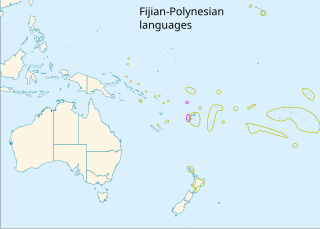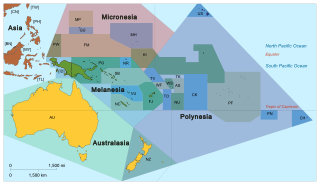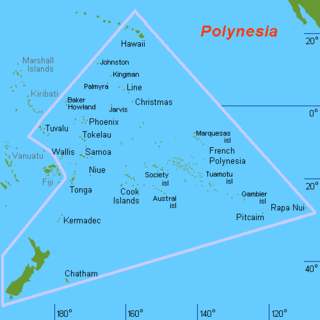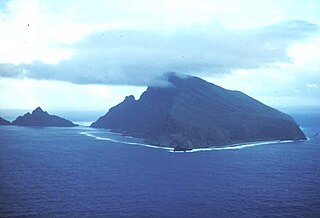This page is based on this
Wikipedia article Text is available under the
CC BY-SA 4.0 license; additional terms may apply.
Images, videos and audio are available under their respective licenses.

The Polynesian narrative or Polynesian mythology encompasses the oral traditions of the people of Polynesia, a grouping of Central and South Pacific Ocean island archipelagos in the Polynesian Triangle together with the scattered cultures known as the Polynesian outliers. Polynesians speak languages that descend from a language reconstructed as Proto-Polynesian that was probably spoken in the Tonga - Samoa area around 1000 BC.

Tuvaluan, often called Tuvalu, is a Polynesian language of or closely related to the Ellicean group spoken in Tuvalu. It is more or less distantly related to all other Polynesian languages, such as Hawaiian, Maori, Tahitian, Samoan, and Tongan, and most closely related to the languages spoken on the Polynesian Outliers in Micronesia and Northern and Central Melanesia. Tuvaluan has borrowed considerably from Samoan, the language of Christian missionaries in the late 19th and early 20th centuries.

The Polynesian languages are a language family spoken in geographical Polynesia and on a patchwork of outliers from south central Micronesia to small islands off the northeast of the larger islands of the southeast Solomon Islands and sprinkled through Vanuatu. They are classified as a subgroup of the much larger and more developed Austronesian family, belonging to the Oceanic branch of that family.

Pacific Islanders or Pasifikas, are the peoples of the Pacific Islands. It is a geographic and often ethnic/racial term to describe the inhabitants of any of the three major sub-regions of Oceania: Micronesia, Melanesia and Polynesia. These people speak various Austronesian languages.
Polynesians are an ethnolinguistic group of closely related peoples who are native to Polynesia, an expansive region of Oceania in the Pacific Ocean. They are part of the larger Austronesian ethnolinguistic group who trace their urheimat to Southeast Asia. They speak the Polynesian languages, a branch of the Oceanic subfamily of the Austronesian language family.
American Samoan may refer to:

Samoans or Samoan people, are a Polynesian ethnic group native to the Samoan Islands, an archipelago in Polynesia, who speak the Samoan language. The group's home islands are politically and geographically divided between the Independent State of Samoa and American Samoa, an unincorporated territory of the United States of America. Though divided by political powers, the culture and language remains one and the same.

Manuʻa, or the Manuʻa Islands Group, in the Samoan Islands, consists of three main islands: Taʻu, Ofu and Olosega. The latter two are now connected by a bridge over the shallow 137-meter-wide Asaga strait. The islands are located some 110 kilometres east of Tutuila and are a part of American Samoa, an unincorporated territory of the United States; their area is 56 square kilometres with a population of 1,400. Taʻu is the biggest island with its 44 square kilometres, and harbours the highest point of the Manuʻa at 931 metres.

Niuatoputapu is a high island in the island nation of Tonga, Pacific Ocean, its highest point being at 157 m. Its name means sacred island. Older European names for the island are Traitors island or Keppel island.

Wikimedia Atlas of American Samoa

A beach fale is a simple thatched hut in Samoa. Beach fales are also common in other parts of Polynesia. They have become popular in tourism as a low budget accommodation situated by the coast, built with a few posts, no walls and a thatched roof with a round or oval shape.

The following outline is provided as an overview of and topical guide to Samoa:

Polynesia is a subregion of Oceania, made up of more than 1,000 islands scattered over the central and southern Pacific Ocean. The indigenous people who inhabit the islands of Polynesia are termed Polynesians, and share many similar traits including language family, culture, and beliefs. Historically, they had a strong tradition of sailing and using stars to navigate at night. The largest country in Polynesia is New Zealand.
Samoan literature can be divided into oral and written literatures, in the Samoan language and in English or English translation, and is from the Samoa Islands of independent Samoa and American Samoa, and Samoan writers in diaspora. Samoan as a written language emerged after 1830 when Tahitian and English missionaries from the London Missionary Society, working with Samoan chiefly orators, developed a Latin script based Samoan written language. Before this, there were logologo and tatau but no phonetic written form.

Oceania is a region centered on the islands of the tropical Pacific Ocean. Conceptions of what constitutes Oceania vary, with it being defined in various ways, often geopolitically or geographically. In the geopolitical conception used by the United Nations, International Olympic Committee, and many atlases, the Oceanic region includes Australia and the nations of the Pacific from Papua New Guinea east, but not the Malay Archipelago or Indonesian New Guinea. The term is sometimes used more specifically to denote Australasia as a geographic continent,
or biogeographically as a synonym for either the Australasian ecozone or the Pacific ecozone.
Samoan Sign Language is the deaf sign language of Samoa.













